
Consumer Reports has no financial relationship with advertisers on this site.
Countertops are like relationships. Some are easygoing and low-maintenance (heres looking at you, quartz), while needier ones demand constant attention. And if youre not willing to put in the effort, you might grow to regret it. Maybe not today. Maybe not tomorrow. But soonand for the rest of your countertop's life.
Joking aside, its important to take proper care of your countertops, one of the major workhorses of your kitchen. Otherwise, your investment can become scratched, cracked, or stained.
"Countertop care isn't one size fits all," says JohnGaleotafiore, director of product testing at CR. "Depending on the material, maintenance could be as simple as wiping it with soapy water or as labor-intensive as oiling it regularly."
So it's critical to know what you should and shouldn't do with your specific counter.
Here, we detail how to clean countertops of various types and keep them in great shape. Find out what kind of maintenance your counter needs, how to clean and remove stains without damaging it, how to repair cuts and scratches, and other useful advice. If you're shopping, it's worth considering all of this.
For specifics on how to clean your existing countertop material, click on the link(s) here:
Butcher BlockConcreteGraniteLaminateMarbleQuartzRecycled GlassSoapstoneSolid SurfacingStainless SteelTile (Ceramic or Porcelain)
To see how all the countertops fare in our rigorous lab tests, see ourcountertop ratings.
Butcher Block
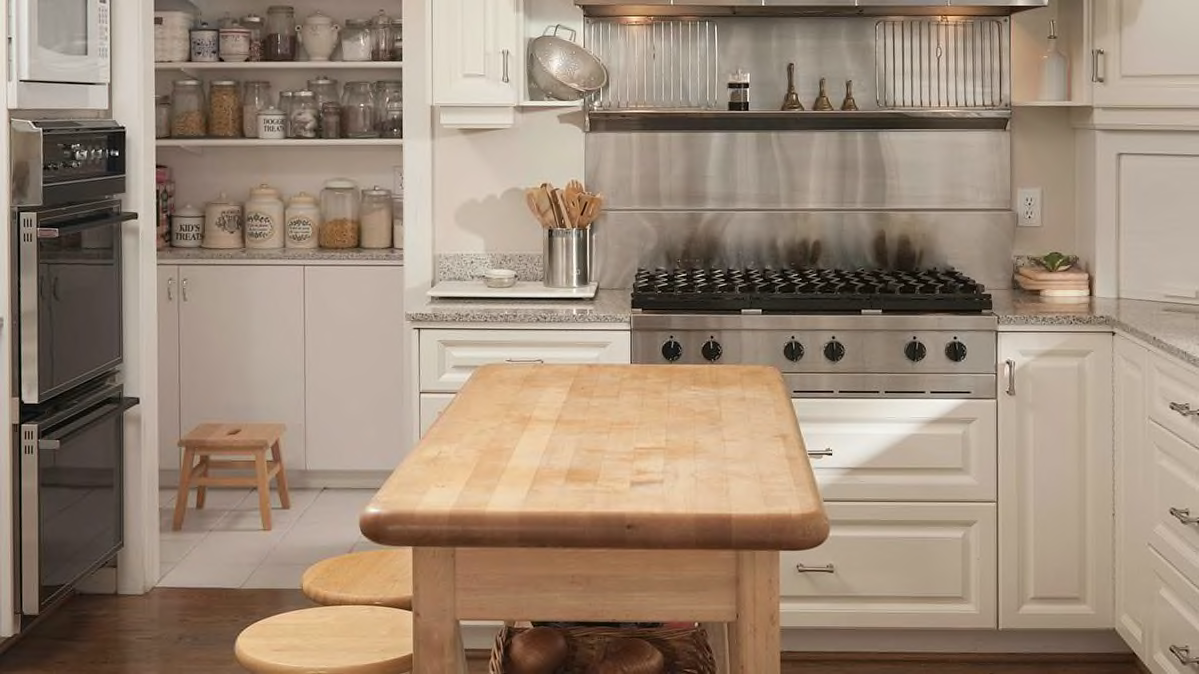
A wood countertop makes for a warm and quiet kitchen (dishes dont clink against it), but it can be high maintenance depending on its finish. Varnished butcher block counters are great at resisting stains, garnering an Excellent rating in our tests, but the varnish can get scratched or melt under heat. Oiled butcher block is the only countertop you can chop and slice on directly, and its safe to place hot cookware on. However, it scores a Poor in our staining test and needs to be oiled regularly to prevent warping or cracking.
Clean It
Whether your butcher block is varnished or oiled, wipe the surface with a clean towel and warm soapy water after each use, and dry it thoroughly with a clean paper towel. To sanitize, use a solution of 1 teaspoon of bleach in 1 quart of water.
For stains in varnished butcher block, use light sandpaper or fine steel wool to buff it out. Depending on how deep the stain is and how far you sand down, you may need to lacquer the surface again.
Oiled butcher block stains can be removed by sprinkling salt on the area and rubbing it with a damp sponge or paper towel. For stubborn stains, sand down the area with fine-grit sandpaper and re-oil the spot. Always sand parallel to the wood grain to avoid tearing the wood fibers. For stuck-on messes, use a bench scraper or metal spatula.
Maintain It
Varnished butcher block doesn't need to be refinished or oiled but does need to be sanded and relacquered if damaged. To protect oiled butcher block, re-oil it at least once a month. Apply an even coating of food-grade mineral oil using a cloth or paper towel. Let it fully penetrate overnight, then wipe off any excess.
For extra protection, apply an even coating of beeswax-based wood cream after youre done oiling the wood. Never use cooking oil to treat butcher block, because it can turn rancid and damage the wood.
If you have varnished butcher block, dont cut directly on the surface (use a cutting board) or place hot cookware directly on it (use a trivet). The heat can melt the varnish; it did in our tests. Use a trivet or hot pad beneath all heat-generating countertop appliances.
Oiled butcher block counters can take more abuse; you can cut on them and place hot pots right on the surface. The material may wear down unevenly if you favor one spot to do all your food prep on, so work in a different area each time.
Repair It
Remove nicks and light scratches in both types of butcher block with fine-grit sandpaper and relacquer or re-oil the spot.
Varnished wood has a coating that protects it. Oiled wood is susceptible to water damage, so never leave liquids sitting on it because they can soak into the countertop and cause it to warp. If that happens, rebalance the moisture in the wood by applying oil liberally to the concave side and tape plastic (cling wrap or dry-cleaning bags) to the convex side. Keep oiling the concave side every day until the wood evens out.
Concrete
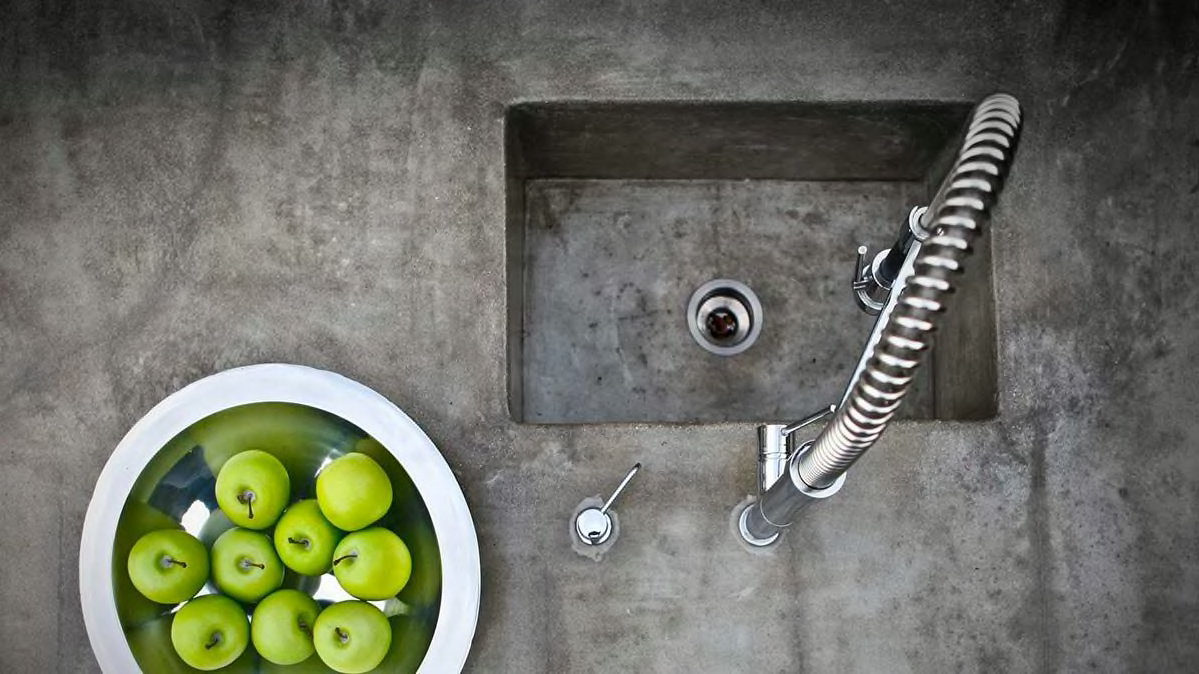
You may think of concretewhich is made of cement and a mix of rocks, sand, and gravelas a tough material. But it chips and scratches easily, and can develop hairline cracks if not properly maintained.
Like most natural countertop materials, concrete is porous and needs to be treated with a topical sealer or penetrating sealer. Topically sealed concrete counters are well-protected against stains and garner an Excellent rating in that test. But its heat resistance rates only a Fair in CR's tests. Concrete counters treated with a penetrating sealer earn an Excellent rating for handling heat but a Poor rating for stain resistance.
Clean It
For both types of concrete counters, use a sponge or towel and mild liquid dishwashing detergent to wipe them down. Avoid abrasive solutions, such as ammonia or bleach, and anything acidic, including citrus and vinegar, which can wear down the sealant and damage the stone in the concrete.
Nonoily food stains like mustard and juice can usually be removed with bleach. Soak a cotton ball or paper towel with bleach, place it on the stain, and set a heavy glass on top for 5 to 10 minutes. Oil-based stains may require more aggressive methods, such as using a poultice made of an absorbent powder and a liquid solvent, which draws the stain out of the concrete.(They're available at hardware stores.)
Maintain It
Always use cutting boards and trivets on concrete counters. Cutting directly on topically sealed concrete countertops can damage the sealer, and acids, including citrus and vinegar, can etch the stone. Contact with hot cookware can discolor the sealer. Placing a hot pad between the counter and heat-generating appliances is also a good idea.
For added protection and a polished look (no matter how the concrete was sealed), apply a food-safe wax on a monthly basis. Use a damp sponge or cloth to apply a thin layer of wax in a circular motion in small sections at a time. Then buff with a dry cloth in the same circular motion. When you notice that water no longer beads up on the surface, it's time to rewax.
Repair It
For minor scratches, use an acrylic sealer and a very fine artist's brush to fill in the scratch. Remove any excess with a cotton swab while the sealer is still wet. Once the touch-up is dry, blend the spot into the rest of the countertop with fine-grit sandpaper or borrow a nail-buffing pad from your manicure kit. You can also hide minor scuff marks with wax, but that's just a temporary fix.
If theres minor etching, rub the spot with fine-grit sandpaper. If the damage is extensive, youll need to hire a professional to sand the spot, fill in the exposed pinholes with grout, and reseal the surface.
The same goes for cracks and chips: Youll need a pro to fill the cavity with a color-matching epoxy, then refinish and reseal it.
Granite
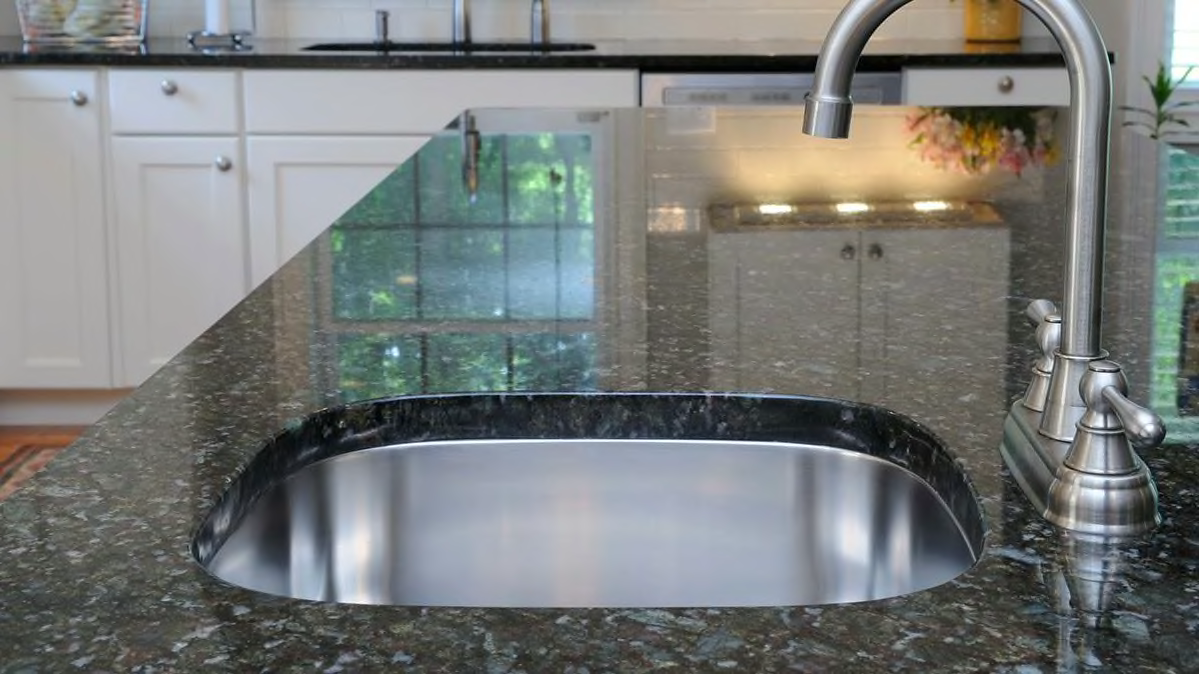
This stone is harder and less porous than other natural surfaces, such as marble and soapstone, making it more resistant to stains and abrasions. Granite can withstand a lot of abuse and garners top scores in our ratings for withstanding our stain, heat, and scratch tests. Most granite countertops dont need to be sealed, according to the Natural Stone Institute, but a sealer will make it even more moisture-resistant than it already is.
Clean It
For daily cleaning, wipe down granite with a nonabrasive sponge or cloth dipped in warm water and mild dishwashing liquid. Dry it with a microfiber cloth to avoid streaking. Don't use acidic cleaners, including vinegar; those chemicals eat away at the stone.
If you need to disinfect the countertop, combine a 50/50 solution of water and rubbing alcohol in a spray bottle and spritz. Let it sit for 3 to 5 minutes before wiping it with a wet cloth and drying with a microfiber cloth.
Maintain It
To seal a granite countertop, be sure to follow the instructions that come with it because methods vary. In general, you need to thoroughly clean granite, rinse it, and dry it well. Youll either spread or spray on a sealer, and let it absorb into the stone for 5 to 15 minutes before wiping off any excess and buffing the surface with a dry cloth. Check the product to see how soon you need to reapply sealer. A good rule of thumb is to reapply it anytime drops of water no longer bead up on the surface.
Repair It
Light surface scratches can be buffed out with dry super-fine steel wool. Deeper scratches and nicks in the surface of the stone should be repaired and repolished by a professional.
To remove etch marks left from contact with acids, wet the surface with water and sprinkle granite polishing powder on top (available at hardware stores). Rub with a damp cloth or buffing pad. Continue buffing until the etch mark disappears and the surface shines. Wipe it clean with a wet cloth thoroughly and let it dry completely before resealing the counter (if the rest of the counter was previously sealed).
If your countertop gets a small crack or chip, you can repair it yourself with a natural stone repair kit found at home improvement stores. These kits often include a syringe of epoxy and the tools you need. Make sure to follow the instructions, but generally youll need to clean the area with an ammonia-based cleaner and dry it thoroughly before filling the damaged area with epoxy until it's level with the surface. Let it dry for at least 24 hours, and then use a razor blade to gently scrape away excess filler. If youd rather not repair it yourself, you can hire a professional.
Laminate
This countertop material is made of layers of paper or fabric that are bonded to composite wood and laminated with resin. The patterns and color options are boundless. Laminates excel at resisting stains and heat in CR's tests. Theyre low maintenance, too, but not completely worry-free; they get scratched and nicked easily.
Clean It
For daily cleaning, use a soft sponge or cloth and mild dishwashing liquid mixed with water. Avoid steel wool, which will dull and scratch the finish. Harsh chemical cleaners like bleach can also abrade and permanently discolor laminate surfaces.
While laminate is one of the most stain-resistant materials in our countertop tests, stains can still happen. Remove them by applying a paste of baking soda and water on the area for 5 minutes to pull out the stain. The paste will be slightly abrasive, so don't rub. Wipe up the paste with a damp cotton cloth and rinse with water.
Maintain It
This countertop doesnt require much maintenance. Just dont cut food directly on it or drag pots and pans across it. That will leave visible marks on the surface, and stains can settle into any cuts and scratches.
Repair It
Youll have to live with any scratches or cuts in a laminate counter because the material cant be easily repaired.
Marble
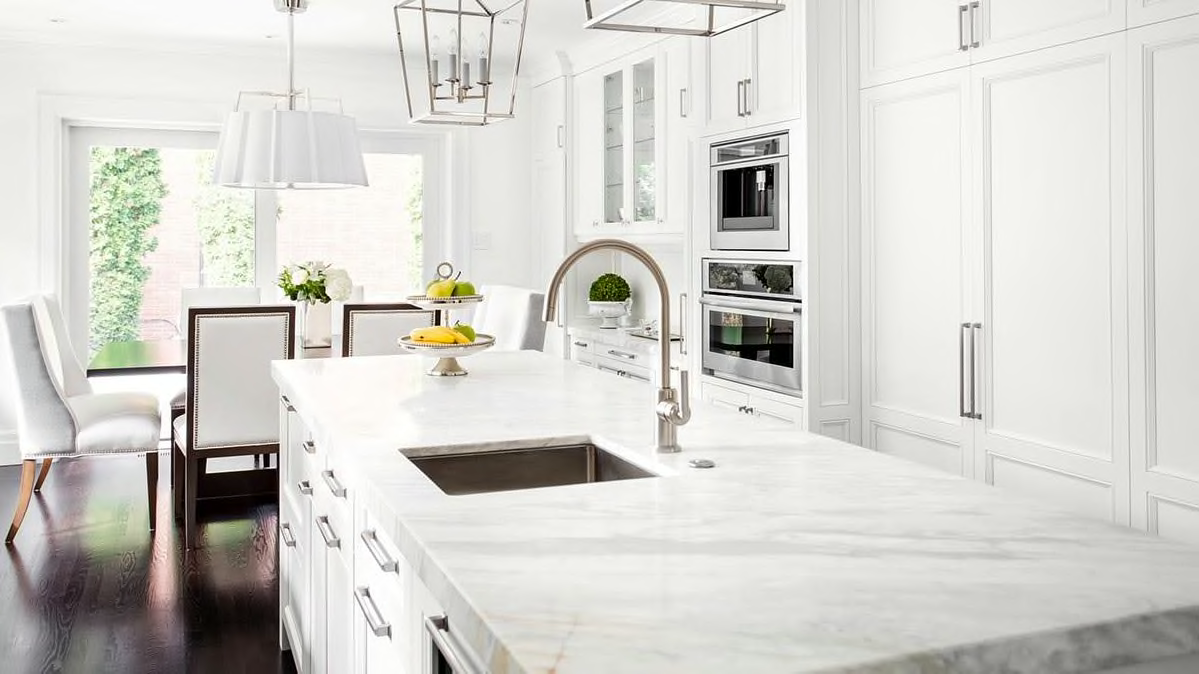
Marbleis beautifuland many engineered materials try to emulate it. But it's the diva of countertops. This stone is porous and soft, making it vulnerable to stains, abrasions, and heat. In fact, it receives either a Poor or Fair rating in all of our countertop tests. If youre not careful, you might have to put in a lot of work removing stains and making repairs. The good news is that most of the damage is repairable.
Clean It
For daily cleaning, use a soft sponge or dishcloth dipped in warm water and mild dishwashing liquid. Dry with a microfiber cloth to avoid streaking. Dont use abrasive or acidic cleaners, including vinegar, because they can dull or permanently etch the stone.
Clean up spills immediately, especially red wine and coffee, which can quickly stain marble even if its sealed. Use a paper towel to blot the spill; wiping will spread it. Flush the area with plain water and mild liquid dishwashing detergent and rinse several times. Dry thoroughly with a soft cloth.
If the stain has set in, clean oil-based ones with acetone, bleach, household detergent, or ammonia. (Don't mix any of these chemicals together.) For coffee and tea stains, mix a few drops of hydrogen peroxide with a drop or two of ammonia. Clean ink stains with bleach or hydrogen peroxide. Rust stains require a poultice, available at hardware stores, to help draw out the stain. If the marble is etched after the treatment, follow the repair instructions below for etch marks.
Maintain It
Be diligent about sealing the marble and wiping up spills immediately. Once properly sealed, the stone will be more resistant to everyday messes.To check whether the sealant is still good, leave a few drops of water on the surface for 15 minutes. If the water soaks into the stone, its time to reseal it.
To seal a marble countertop, be sure to follow the instructions that come with the product. In general, you should thoroughly clean the marble with mild liquid dishwashing detergent, then rinse and dry it well. Youll either spread or spray on the sealer and let it absorb into the stone for 5 to 15 minutes before wiping off any excess and buffing with a dry cloth.
Don't place hot pots or pans right off a stove or out of an oven directly on the countertop; this can cause it to crack.Trivets are your friend.
Always use cutting boards for food prep, because marble is very susceptible to scratches.
Don't let acidic foods, such as citrus, vinegar, and tomatoes, come into contact with marble. Acids will quickly etch the stone. Always place coasters under wine glasses and coffee cups to help avoid stains.
Repair It
Slight surface scratches may be buffed with super-fine steel wool. Deeper scratches and nicks in the surface of the stone should be repaired and repolished by a professional.
Etch marks caused by acids can be removed. First, wet the surface with water and sprinkle marble polishing powder on top (available at hardware stores). Rub the powder on the stone with a damp cloth or buffing pad. Continue buffing until the etch mark disappears and the marble surface shines. Rinse thoroughly and let dry completely before resealing the counter.
If your countertop gets a small crack or chip, you can fix it using a natural stone repair kit you can buy at a home improvement store. See the repair advice for granite, above, for what to do.
Quartz
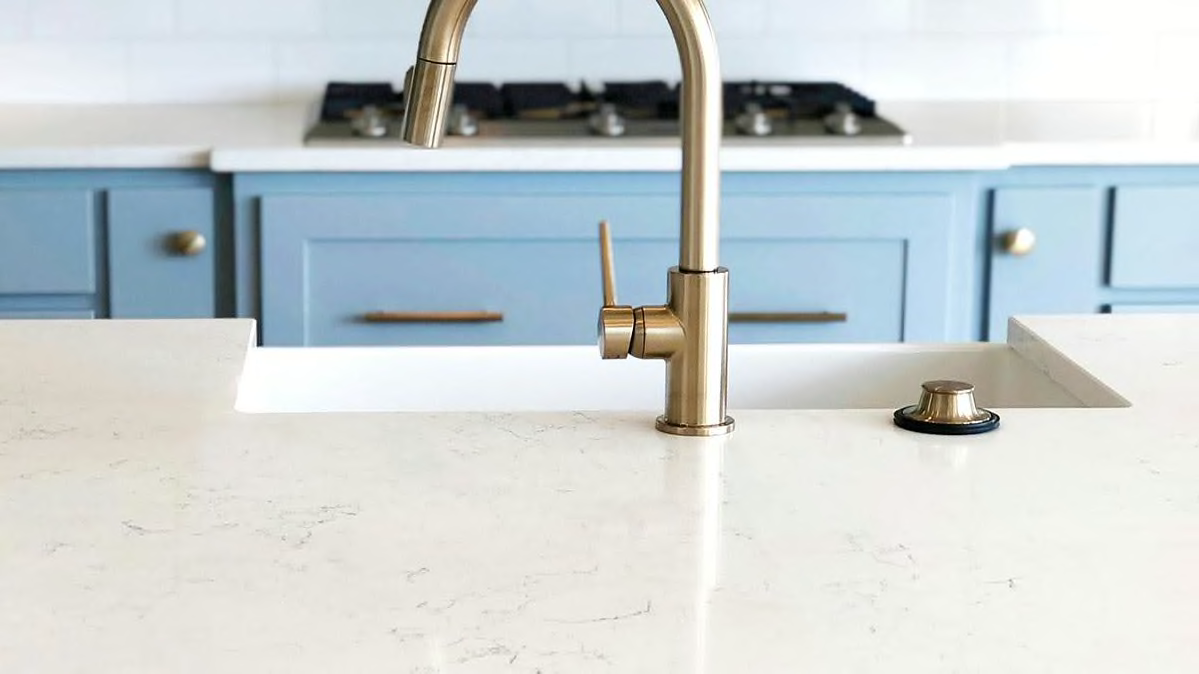
This hardy countertop combines the best that synthetics and nature have to offer. The engineered material is made of stone chips, resins, and pigments, a combo that offers the look of real stone while allowing it to withstand a fair share of abuse. Quartz is strong (it tops many of our countertop tests), waterproof, and doesnt need to be sealed.
Clean It
For routine cleaning, simply wipe down the countertop with a damp cloth or paper towel and, if necessary, a small amount of nonbleach, nonabrasive cleanser. A solution of rubbing alcohol and water will also work well.
For stubborn or dried-up messes, use a nonabrasive cleaner such as Soft Scrub.
To fight food stains, mix 2 tablespoons of hydrogen peroxide, one cup of flour, and enough water to make a paste. Apply to the stain, cover with plastic, and let the mixture dry for up to 24 hours before removing with warm water and a soft cloth. For ink stains, moisten a cloth with Goo Gone or a comparable oil-based product, and rub it into the stain. Rinse thoroughly with warm water to remove any residue.
Maintain It
Compared with many of the other countertops on this list, quartz is practically no-maintenance. Just avoid dropping heavy objects on it, which could crack or chip it. So be careful with those cast-iron pots and pans.
Repair It
As with granite and marble, if by chance your quartz countertop gets a small crack or chip, you can repair it yourself with a repair kit you can buy at a home improvement store.
Recycled Glass
Most recycled glass countertops feature a mosaic of shards or finely ground glass embedded in a binder. The result is an artistic, colorful countertop that resists heat, cuts, and abrasions very well in our tests but cracks easily under impact. It can be low-maintenance depending on the binder thats used. If it's a resin, the countertop will be nonporous and won't need to be sealed. But some brands use cement as the binder, which means the countertop will require a sealant to prevent stains and etching. You should follow the care and maintenance tips for concrete (above). The tips below are for recycled glass countertops made with resin.
Clean It
For daily cleaning, use a damp cloth and mild all-purpose cleaner. Don't use bleach or harsh chemical cleaners.
For stubborn stains, leave an all-purpose cleaner on it for a bit before scrubbing with a nonabrasive sponge.
Maintain It
Other than being watchful for potential stains and heavy objects that can crack or chip the surface, recycled glass countertops require no special maintenance.
Repair It
Cracks and chips need to be repaired by the fabricator. If a piece of glass pops out, be sure to save it so it can be reinserted.
Soapstone
Naturally nonporous and fairly stain-resistant, soapstone countertops give you a natural look without the fuss; no sealing is required. It withstands heat very well but is on the soft side for a stone, so its vulnerable to scratches and abrasion, earning a low score in those areas in CR's tests.
Clean It
Soapstone is resistant to chemicals and acids, so you dont need to worry about harsh chemicals and acidic foods etching it. Cleaning requires little more than water and a mild all-purpose cleaner or liquid dishwashing detergent.
Maintain It
New soapstone is light gray in color but darkens to a rich charcoal when it's exposed to oils. To make sure it darkens uniformly, treat it with mineral oil. For the first oiling, pour mineral oil directly onto the surface of the soapstone and rub it over the entire surface with a dry cloth. Let it sit for 30 minutes, then wipe off excess oil.
Re-oil once a month for a few months and up to a couple of years, depending on how dark you want your soapstone. A general guide is to reapply the mineral oil when water leaves a noticeable spot on the surface.
You can place hot cookware directly on soapstone; the heat wont crack it. But rough materials such as cast iron can scratch it. So be careful not to drag heavy pans across the surface. Never use sharp tools directly on it, either.
Repair It
Smaller scratches can be removed or disguised using mineral oil. Larger scratches can be buffed out with sandpaper. Sand the scratched area in a circular motion until the scratch is almost gone, then use a finer-grit sandpaper to do the same thing, but this time with a little water. Because sanding will lighten the spot, apply oil to it afterward. It may require several coats until the color matches the rest of the counter.
Solid Surfacing
Solid surfacing is a manufactured material made from polymer resins mixed with minerals and colorants. It can be a solid color or made to look like stone and even metal. It's nonporous, fairly heat-resistant, and fends off most stains in CR's tests. While you dont need to seal it, it does scratch and cut easily.
Clean It
For daily cleaning, use warm soapy water or ammonia-based cleaners.
To sanitize, wipe the surface with diluted bleach (1 tablespoon of bleach to 3 cups of water).
Maintain It
Keep your countertops dry. Film builds up on the surface if water is left on it, making the countertop look blotchy and uneven.
Don't put hot pots or pans directly on the counter; use a trivet.
Repair It
Solid surfacing can be scratched, but its fixable. Remove fine scratches or stubborn stains by applying a mild liquid abrasive such as Soft Scrub, and rub with a damp sponge or cloth in small circular motions. Rinse thoroughly and dry completely. Repeat with more pressure if scratches remain. For cuts, wash the area with hot soapy water and dry it. Rub the scratch with fine-grit sandpaper, then buff with a scouring pad in a circular motion. If the countertop has a glossy finish or a deep cut, its best to call in a professional.
Stainless Steel
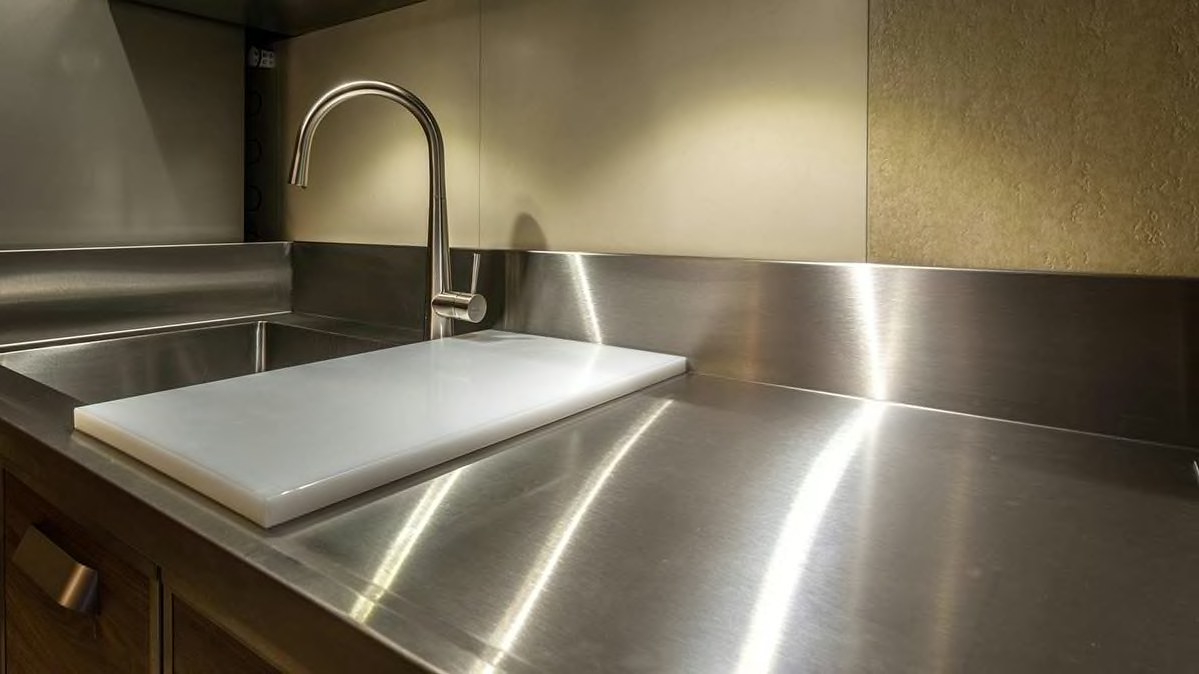
Impervious to heat, stain-resistant, and easy to clean, stainless steel is a countertop material designed for serious cooks. Its nonporous, and you dont have to worry about putting hot cookware right on it. That said, stainless steel isn't indestructible. It dents and scratches easily; it receives low scores for those traits in CR's tests, which ultimately places it near the bottom of our ratings. Some chemicals can discolor it.
Clean It
For daily cleaning, use warm water and liquid dishwashing detergent or ammonia and a nonabrasive sponge or soft cloth. Rinse with water and wipe dry. Avoid steel wool pads, which can leave steel particles on the surface and quickly form rust deposits. Bleach or acids can stain and corrode the surface if not thoroughly rinsed with water.
Maintain It
Never leave acidic foods like citrus, tomatoes, and vinegar on the countertop for long periods of time; the acid can stain the surface.
Stainless steel scratches easily, so always cut food on a cutting board, not directly on the counter.
To protect and maintain the shine, use a stainless steel cleaner or polish periodically.
Repair It
Minor scratches can be buffed out with a scouring pad. Deep scratches will require sanding and then buffing with a scouring pad. When scouring and buffing, follow the grain (the pattern may be circular or in brushed lines going in one direction). If the counter gets a dent, youll have to hire a pro to try to flatten it out. If that doesnt work, you'll need to replace the panel.
Tile (Ceramic and Porcelain)
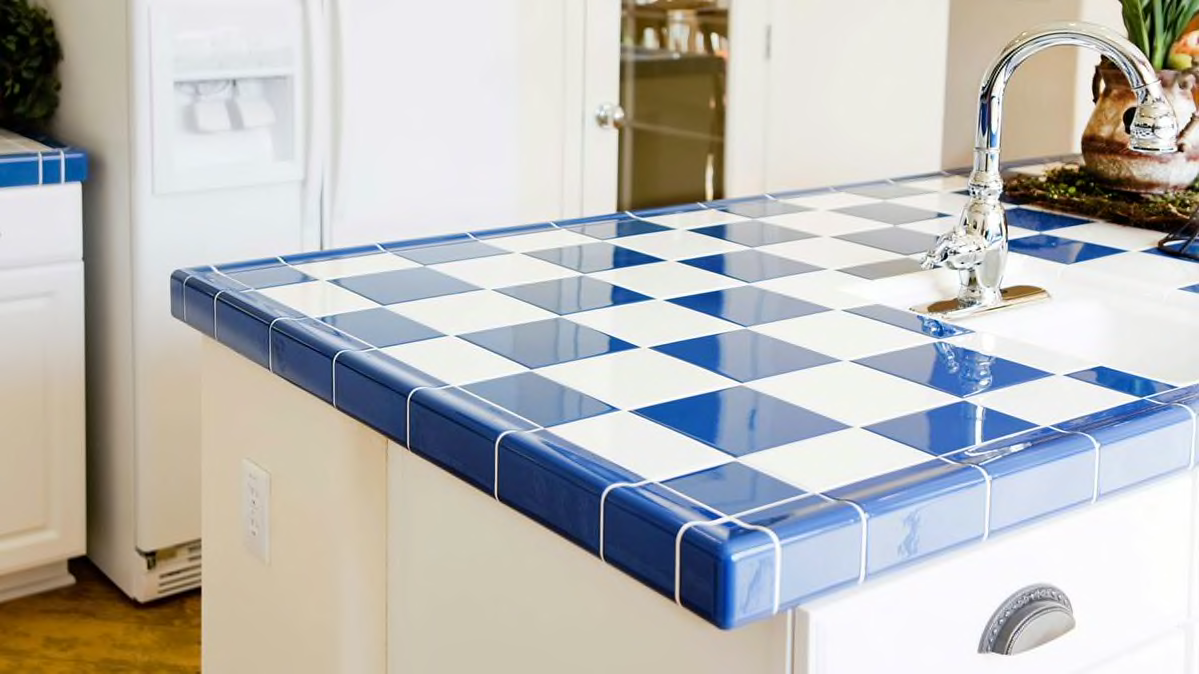
Tile is water- and heat-resistant, making it an ideal material to use near stoves and a good match for cooks who cant be bothered with trivets. In our countertop tests, tile gets Excellent ratings for its ability to resist scratches and heat damage. But while tile is good at keeping stains at bay, the grout can stain and mildew if youre not diligent about sealing it.
Clean It
For daily cleaning, use a gentle all-purpose spray cleaner. Don't use harsh cleaning products, because they can damage grout and glazed tiles.
For grout stains and mildew, dip a toothbrush in diluted bleach (1 tablespoon of beach and 2 cups of water) and scrub the area, or use a special grout cleaner.
Porcelain tiles are resistant to scratches, etching, and food stains, but ink stains can be permanent, so be careful when youre writing on it. For ceramic tile stains, try baking soda and water for oil-based stains; hydrogen peroxide for coffee, tea, and juice; and diluted bleach (again, 1 tablespoon of beach and 2 cups of water) for inks and dyes.
Maintain It
Seal grout at least once a year with an interior grout sealer that's compatible with the type of tile on your countertops.
Repair It
If tiles break, you can call in a pro or replace them yourself. Chisel out the broken tile and insert a new one, then regrout and reseal around it.
Consumer Reports is an independent, nonprofit organization that works side by side with consumers to create a fairer, safer, and healthier world. CR does not endorse products or services, and does not accept advertising. Copyright 2020, Consumer Reports, Inc.
